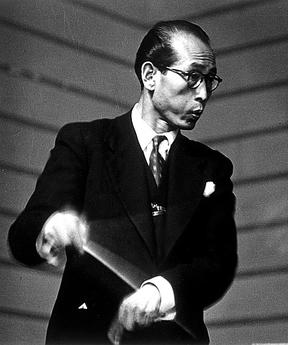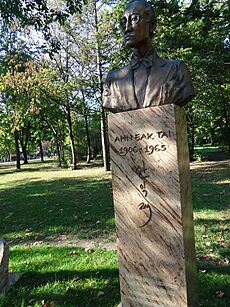Ahn Eak-tai facts for kids
Quick facts for kids
Ahn Eak-tai
|
|
|---|---|

Ahn Eak-tai in 1955.
|
|
| Born | 5 December 1906 |
| Died | 16 September 1965 (aged 58) Mallorca, Spain
|
| Burial place | Seoul National Cemetery |
| Nationality | Korean Empire->Francoist Spanish |
| Alma mater | Kunitachi College of Music University of Cincinnati Curtis Institute of Music |
| Known for | Composer of the South Korean national anthem |
| Spouse(s) |
Lolita Ahn (née: Talavera)
(m. 1945) |
| Korean name | |
| Hangul |
안익태
|
| Hanja | |
| Revised Romanization | An Iktae |
| McCune–Reischauer | An Ikt'ae |
Ahn Eak-tai (Korean: 안익태; Hanja: 安益泰, pronounced [ɐn.ik̚tʰε]; 5 December 1906 – 16 September 1965) was a famous South Korean classical music composer and conductor. He led many big orchestras across Europe. These included the Vienna Philharmonic Orchestra and the Berlin Philharmonic Orchestra.
Ahn Eak-tai is best known for writing "Aegukga". This song became the national anthem of South Korea. He also composed other important works like Korean Dance and Symphonic Fantasy Korea. Some of his other pieces were found only recently.
Ahn was born in Korea before it was under Japanese rule. He went to a school run by missionaries. There, he discovered his love for music by playing the trumpet. He studied music in Japan, the United States, Austria, and Hungary. In Vienna, he got help from the famous composer Richard Strauss. This helped him finish his Symphonic Fantasy Korea.
Ahn spent five years conducting concerts in Europe. When World War II started, he moved to Spain. There, he met Lolita Talavera, who later became his wife. After they married in 1946, they moved to the United States. Ahn conducted the Philadelphia Orchestra there. In 1955, Ahn returned to South Korea. He led the Seoul Philharmonic until he passed away.
Contents
Early Life and Music
Ahn Eak-tai was born on December 5, 1906, in Pyongyang. This city is now the capital of North Korea. His family was wealthy, and his father wanted his children to get a good education. Ahn Eak-tai was the third of six children.
Ahn loved music from a young age. He sang hymns at a village church. His older brother bought him a Suzuki violin and records. This helped Ahn start playing music early on.
In 1914, he began elementary school and learned to play the trumpet. Later, at Pyongyang Soongsil Middle School, he joined the school orchestra. He received a cello as a gift and took private lessons.
Standing Up for Korea
In 1919, Ahn's school orchestra took part in the March 1st Movement. This was a big protest by Koreans against Japanese rule. This experience made Ahn very passionate about Korean independence.
He even led a student protest against teachers who supported Japan. The school punished him for this. Later, Ahn tried to help activists who were caught by the Japanese police. He had to flee to his principal's house to avoid arrest.
The principal helped Ahn avoid jail. He arranged for Ahn to go to Tokyo to study music. This was a way for Ahn to escape trouble and continue his passion.
Studying Music in Japan
On October 6, 1919, Ahn traveled to Japan. He got into Tokyo Seisoku Middle School. In 1926, he was accepted into the Kunitachi College of Music.
In the summer of 1926, Ahn visited Korea. He performed music to raise money for a church that had burned down. He met important independence leaders there. One leader asked Ahn to help promote Korean-made products. Ahn played his cello from a car to encourage people to buy Korean goods.
In 1928, Ahn's father died. His mother struggled to pay for his schooling. Ahn worked as a cellist in a restaurant to earn money. But it still wasn't enough. He even broke his cello and had to borrow one. A Japanese friend bought him a new violin. Finally, his teacher paid his remaining tuition, allowing him to graduate. A Japanese newspaper called him "a genius with a bright future."
Journey to the United States
In May 1930, Ahn returned to Korea. His former principal suggested he study in the United States. Ahn realized he needed to leave Korea to avoid problems with the Japanese police.
When he arrived in San Francisco, Ahn was briefly jailed. He refused to let officials take his cello during inspection. A prison guard, surprised by a musician being jailed, helped him get released the next day.
In San Francisco, Ahn visited a Korean church. He heard the Korean national anthem being sung to the tune of a Scottish song, "Auld Lang Syne". Ahn felt this tune was not right for a national anthem. He decided to write a new one for Korea.
A pastor gave him a suitcase and a pen to write the new anthem. Ahn then traveled to Cincinnati. He entered the University of Cincinnati College Conservatory of Music. He worked at a restaurant to support himself during the Great Depression.
In 1930, Ahn became the first cellist in the Cincinnati Symphony Orchestra. He toured the United States, performing in major cities. He even performed at Carnegie Hall in New York City, receiving good reviews.
Becoming a Conductor
After his successful tour, Ahn decided he wanted to be a conductor instead of a cellist. In 1935, he moved to the Curtis Institute of Music in Philadelphia, graduating in 1936.
Around this time, Ahn led a church choir. A famous conductor, Leopold Stokowski, heard about Ahn and invited him to join the Philadelphia Orchestra. However, Ahn was focused on writing his first big orchestral piece, Symphonic Fantasy Korea. His neighbors, the Peables, helped him by paying his rent.
Ahn entered Symphonic Fantasy Korea in a competition at Carnegie Hall. He got the chance to conduct the New York Philharmonic for its first performance. But the performance was difficult, and Ahn couldn't control the orchestra well. He threw down his baton in frustration. The audience wanted him to try again, but he refused. The Peables praised his actions and offered to send him to Europe to study conducting.
Studying and Conducting in Europe
On April 8, 1936, Ahn left New York for Europe. He went to Berlin and finished writing "Aegukga", the new Korean national anthem. He sent it to a Korean independence group in San Francisco. He also put the final touches on Symphonic Fantasy Korea.
Ahn moved to Vienna, Austria, to study with Bernhard Paumgartner, a famous composer. In 1937, he went to Hungary to study with Zoltán Kodály. He used these lessons to improve Symphonic Fantasy Korea.
In 1937, Ahn performed Symphonic Fantasy Korea in Dublin, Ireland. The Irish audience loved it because Ireland had also been under foreign rule, like Korea. He then met with Richard Strauss in Vienna to discuss his symphony.
Ahn also studied at the Eötvös Loránd University on a scholarship. He graduated in 1939. Strauss was impressed with Ahn's talent. He asked Ahn to conduct a concert in Budapest in his place. Ahn worked so hard that he collapsed during the last piece. But Hungarian newspapers still praised him.
Strauss recommended Ahn to the Rome Philharmonic Orchestra, which gladly accepted him. Many other orchestras across Europe then invited Ahn to conduct. He traveled all over Europe performing.
In December 1940, Ahn conducted the Berlin Philharmonic Orchestra. German newspapers wrote great things about him. He continued to lead many famous orchestras. However, the Japanese government didn't like his Symphonic Fantasy Korea. They thought it was too political. Because of this, Ahn was stopped from performing it with the Rome Philharmonic Orchestra.
He found other places to work, like the Orchestre de Paris. But he had to leave in 1944 when Paris was freed from German forces. He was then invited to conduct for the Orquestra Simfonica de Barcelona in Spain.
Life in Spain and Return to Korea
In Spain, Ahn met Lolita Talavera (1915–2009). She was a big fan of his music. She understood Korea's situation under Japanese rule, and Ahn felt understood by her. They got engaged and married on July 5, 1946.
They moved to the island of Majorca, where Ahn started the Orquesta Sinfónica de Mallorca. He wanted to work in the United States, but his past connection with Richard Strauss caused problems for two years. Eventually, he was allowed to join the Philadelphia Orchestra.
On August 15, 1948, Ahn's "Aegukga" was sung at the ceremony celebrating the start of the Korean government. After the Korean War, President Syngman Rhee invited Ahn back to Korea. On February 19, 1955, Ahn returned home after 25 years. The military band played "Aegukga" when he arrived. He was later given the Cultural Medal of Merit.
Ahn also conducted concerts in Japan in 1960 and 1964. He encouraged Koreans living there to unite. He organized three Seoul International Music Festivals.
On September 16, 1965, Ahn became suddenly ill and passed away on the island of Mallorca. He had lived there for 20 years. On July 8, 1977, his ashes were moved from Majorca to the Korean National Cemetery in Seoul.
See Also
- Hong Nan-pa
- Korean music
- List of South Korean musicians
- List of North Korean musicians


